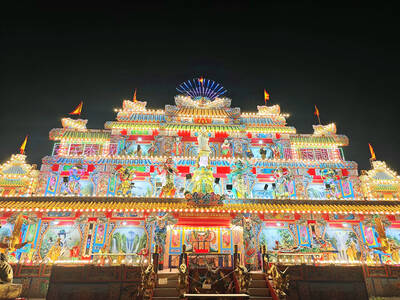I expected a good show from Formosa Indigenous Dance Foundation of Culture and Arts (原住民族樂舞劇), whose latest production, Maataw: the Floating Island (浮島), was at the National Theater in Taipei last weekend, and that was what I saw.
What I did not expect was a powerful piece of political theater, one that spared few punches in attacking the government’s paternalistic treatment of Taiwan’s indigenous people and its promotion of cultural tourism and nuclear power.
Unfortunately, if Friday night’s audience, with its large number of Aboriginal attendees, was anything to judge by, the people who should see the show probably missed it.

Photo courtesy of Kaohsiung City Ballet
It is not the first time that the Hualien-based foundation, or its Formosa Aboriginal Song and Dance Troupe (原舞者) component, have tackled a sensitive topic. A show I saw in 2011, Dreaming of Azalea Mountain (迴夢杜鵑山), was a tribute to Uyongu Yatauyungana, a Tsou community teacher, leader and musician from Alishan who was killed during the White Terror.
However, that show addressed the past. Maataw, which tells of the Tao of Orchid Island (Lanyu, 蘭嶼), is an indictment of the past and present.
Kudos to the creative team of Faidaw Fagod, the troupe’s artistic director, and choreographer and director Fangas Nayaw, as well as set designer Tsai Yin-han (蔡茵涵), visual designer Hsu Yi-chun (徐逸君), costume designer Keith Lin (林秉豪) and lighting designer Chuang Chih-heng (莊知恆).

Photo courtesy of the Formosa Indigenous Dance Foundation of Culture and Arts
The program explains that the title comes from the Tao world ataw combined with the prefix ma, which together means an island seen from the ocean. It is told as a dialogue between Taiwan and Orchid Island (蘭嶼), also known as Lanyu, as reflected in the encounters between the Tao and outsiders, tradition and the modern world, the Tao community and the nation.
While the show is performed in the Tao language, with Chinese surtitle screens on both sides of the stage, one does not have to speak either language to get the show’s message.
The two-act show is divided into five parts: a prelude, Mivanwa (calling the flying fish) and Mivaci (pounding the millet). After the intermission, the pace picks up with Mikaryag (singing gathering) — when the intrusions of tourists becomes increasingly obnoxious — and Mamaway (spirit up), which brings up the topic of the government and Taiwan Power Co’s subterfuge in building a nuclear waste storage facility on Lanyu.
Outsiders, from the tourists who slither out from beneath the walls and rocks of the set, to the three politicians — color-coded according to the Taiwanese political spectrum in all-blue, all-green or all-orange outfits — who prance and preen (especially the man in blue) through a Tao ceremony are depicted as insensitive louts (and bringers of lots of plastic trash).
The final segment — with the clicking of a Geiger counter and an English-language voiceover that repeatedly states that construction of the nuclear facility was disguised as the building of a fish-processing plant — shows the Tao being repeatedly beaten down by outside forces, but continuing to fight for their right to exist on their own land. The dancers pound the stage with their feet, fall and force themselves up, again and again, each time holding their right arm high and somehow gathering more strength with each fall and rise, while a video projection filmed from a spinning camera shows dizzying shots of Lanyu from the ground and the sea.
As I watched the final part of the show, I found it hard to believe that a government agency — the Council of Indigenous Peoples — paid for the production, given the level of criticism of government policies. During a brief after-show chat with one of the production team, it turns out that the council “hated the second act, but because the songs are indigenous songs, they couldn’t do anything about it.”
Maataw begins a national tour in March, with performances in Tainan (March 5), Hualien (March 12), Pingtung County (April 9), Lanyu (May 7) and Taoyuan (May 14). The program said tickets will be available online through www.artsticket.com.tw, although I have not been able to find the listings yet, or by calling the foundation at (03) 864-2290.
For those who missed it in Taipei, this is a show worth traveling to see.
At the invitation of Kaohsiung City Ballet (KCB, 高雄城市芭蕾舞團) founder Chang Hsiu-ru (張秀如), I traveled to Kaohsiung on Saturday to see the Dance Shoe 2016 (點子鞋) production, having missed the show when it was in Taipei the previous weekend.
Chang hit upon a winning formula 13 years ago and it is one that she will hopefully continue: Take a handful of southern-grown or based choreographers and let them decide what they want to create and on whom. The productions give the choreographers a chance to have their work shown, KCB’s dancers gain more performing time and audiences around the nation have a chance to see a variety of works.
Chang Ya-ting’s Murmurs (喃喃) opens the show with the four dancers given a chance to show their strengths in a combination of duets and solos.
Wang Wei-ming’s (王維銘) The Stories They Told (她們在說故事) is composed of short solos for five women, each different in style, costuming and intensity, to a score that ranged from a clip from the sountrack to Wim Wenders’ Pina to a Pucchini violin piece.
Lai Hung-chung’s (賴翃中) Grim Winter (凜凜) featured a very strong Cheng I-han (鄭伊涵), whose steely resolve sometimes appeared to overpowered her partner, Huang Yu-hsuan (黃于軒), in a piece that incorporated contemporary popping and isolationist techniques with more traditional ballet movements.
Wang Kuo-chuan’s (王國權) Fragments of Madrid (馬德里的片段), danced by Wang and KCB veteran Ally Yeh (葉麗娟) simply sizzled. At the start, Wang is miffed at Yeh — a girlfriend or perhaps a former lover — for being tardy, but a quick tango-ish embrace and they took off on a romantic and very sexy romp. A very grown-up piece performed by two very experienced dancers, it was terrific fun.
The final work on the program, Dai Ting-ru’s (戴鼎如) very elegant Waiting (從你的全世界路過), danced by Dai, Li Po-wei (李博偉) and Hsia Chia-hui (夏嘉徽), spoke eloquently of love, loss and longing.
There will be two final performances of Dance Show 2016 on Saturday at the Tainan Municipal Cultural Center.

It’s a good thing that 2025 is over. Yes, I fully expect we will look back on the year with nostalgia, once we have experienced this year and 2027. Traditionally at New Years much discourse is devoted to discussing what happened the previous year. Let’s have a look at what didn’t happen. Many bad things did not happen. The People’s Republic of China (PRC) did not attack Taiwan. We didn’t have a massive, destructive earthquake or drought. We didn’t have a major human pandemic. No widespread unemployment or other destructive social events. Nothing serious was done about Taiwan’s swelling birth rate catastrophe.

Words of the Year are not just interesting, they are telling. They are language and attitude barometers that measure what a country sees as important. The trending vocabulary around AI last year reveals a stark divergence in what each society notices and responds to the technological shift. For the Anglosphere it’s fatigue. For China it’s ambition. For Taiwan, it’s pragmatic vigilance. In Taiwan’s annual “representative character” vote, “recall” (罷) took the top spot with over 15,000 votes, followed closely by “scam” (詐). While “recall” speaks to the island’s partisan deadlock — a year defined by legislative recall campaigns and a public exhausted

In the 2010s, the Communist Party of China (CCP) began cracking down on Christian churches. Media reports said at the time that various versions of Protestant Christianity were likely the fastest growing religions in the People’s Republic of China (PRC). The crackdown was part of a campaign that in turn was part of a larger movement to bring religion under party control. For the Protestant churches, “the government’s aim has been to force all churches into the state-controlled organization,” according to a 2023 article in Christianity Today. That piece was centered on Wang Yi (王怡), the fiery, charismatic pastor of the

Hsu Pu-liao (許不了) never lived to see the premiere of his most successful film, The Clown and the Swan (小丑與天鵝, 1985). The movie, which starred Hsu, the “Taiwanese Charlie Chaplin,” outgrossed Jackie Chan’s Heart of Dragon (龍的心), earning NT$9.2 million at the local box office. Forty years after its premiere, the film has become the Taiwan Film and Audiovisual Institute’s (TFAI) 100th restoration. “It is the only one of Hsu’s films whose original negative survived,” says director Kevin Chu (朱延平), one of Taiwan’s most commercially successful